Are You Sure? (archive) (nonfiction): Difference between revisions
No edit summary |
No edit summary |
||
| Line 2: | Line 2: | ||
== Are You Sure ...? == | == Are You Sure ...? == | ||
=== April 28 === | |||
<br> | |||
<br> | |||
<br> | |||
<span style="font-size:90%;letter-spacing:.4rem">GNOMON CHRONICLES</span> | |||
[[File:Adele and Kurt (cropped).jpg|thumb|175px|link=Kurt Gödel (nonfiction)|[[Kurt Gödel (nonfiction)|Adele Porkert and Kurt Gödel]] in Vienna during their courtship (mid-1930s).<br><br>The text under the [[:File:Adele and Kurt.jpg|complete photograph]] reads:<br>"Adele Porkert and Gödel were an unlikely but devoted couple. This photograph, taken at an outdoor Viennese cafe, is from the period of their long courtship. Porkert shielded Gödel from the worst of his irrational fears, and was often the only person who could persuade him to eat. More than anyone else, she was responsible for keeping him alive and productive."<br><br>After his wife's hospitalization in 1977, Gödel stopped eating and starved to death.]] | |||
<span style="font-weight:bold">Are You Sure ... (April 28, 2020)</span> | |||
• ... that logician, mathematician, and analytic philosopher '''[[Kurt Gödel (nonfiction)|Kurt Gödel]]''' (1906–1978) shocked his colleagues with his [[Gödel's incompleteness theorems|incompleteness theorems]], which use [[Mathematical logic (nonfiction)|mathematical logic]] itself to prove that mathematical logic (which might be thought of as the science of being certain) is inherently subject to uncertainty; that Gödel's work shook mathematics to its [[Foundations of mathematics (nonfiction)|foundations]], establishing fundamental principles of modern thought; and that Gödel suffered periods of mental instability and illness, with an obsessive fear of being poisoned, eventually eating only food that his wife, Adele, prepared for him; and that after her hospitalization in 1977, when she could no longer prepare her husband's meals, he starved to death? | |||
• ... that physicist and engineer '''[[Rolf Landauer (nonfiction)|Rolf Landauer]]''' (1927–1999) made important contributions to the thermodynamics of information processing, including the principle that in any logically irreversible operation that manipulates information, such as erasing a bit of memory, [[Entropy (nonfiction)|entropy]] increases and an associated amount of energy is dissipated as heat, a phenomenon now known as [[Landauer's principle (nonfiction)|Landauer's principle]]? | |||
• ... that '''[[Geometrical frustration (nonfiction)|geometrical frustration]]''' (or simply '''frustration''') is a phenomenon in condensed matter physics where atoms tend to stick to non-trivial positions or where, on a regular crystal lattice, conflicting inter-atomic forces (each one favoring rather simple, but different structures) lead to quite complex structures, and that as a consequence of the frustration in the geometry or in the forces, a plenitude of distinct [[Ground state (nonfiction)|ground states]] may result at zero temperature, and usual thermal ordering may be suppressed at higher temperatures? | |||
• ... that mathematician '''[[Leopold Kronecker (nonfiction)|Leopold Kronecker]]''' (1823–1891) was quoted by [[Heinrich Martin Weber (nonfiction)|Heinrich Martin Weber]] (1893): "Die ganzen Zahlen hat der liebe Gott gemacht, alles andere ist Menschenwerk" ("God made the [[Integer (nonfiction)|integers]], all else is the work of man")? | |||
<div style="font-size:90%;letter-spacing:.4rem;float:right;color:#555555">GnomonChronicles.com</div> | |||
<br style="clear:both> | |||
=== April 27 === | |||
<br> | |||
<br> | |||
<br> | |||
<span style="font-size:90%;letter-spacing:.4rem">GNOMON CHRONICLES</span> | |||
[[File:John Ehrlichman (1969).png|thumb|175px|link=John Ehrlichman (nonfiction)|"The Nixon campaign in 1968, and the Nixon White House after that, had two enemies: the antiwar left and black people. You understand what I’m saying? We knew we couldn’t make it illegal to be either against the war or black, but by getting the public to associate the hippies with marijuana and blacks with heroin, and then criminalizing both heavily, we could disrupt those communities. We could arrest their leaders, raid their homes, break up their meetings, and vilify them night after night on the evening news. Did we know we were lying about the drugs? Of course we did."<br>—'''[[John Ehrlichman (nonfiction)|John Ehrlichman]]''', White House counsel and presidential aide, quoted in "Legalize it all", Harper's Magazine, April 2016.]] | |||
<span style="font-weight:bold">Are You Sure ... (April 27, 2020)</span> | |||
• ... that former White House counsel and Presidential aide '''[[John Ehrlichman (nonfiction)|John D. Ehrlichman]]''' (b. 1925) was released from an Arizona prison on this day in 1978 after serving eighteen months for [[Watergate scandal (nonfiction)|Watergate]]-related crimes? | |||
• ... that painter and inventor '''[[Samuel Morse (nonfiction)|Samuel Morse]]''' (1791–1872) met artist and pioneering photographer [[Louis Daguerre (nonfiction)|Louis Daguerre]] in 1839 while visiting Paris, and that Morse become interested in the daguerreotype (the first practical means of photography), writing a letter to the ''New York Observer'' describing the invention; and that [[Mathew Brady (nonfiction)|Mathew Brady]], one of the earliest photographers in American history, famous for his depictions of the American Civil War, studied under Morse and later took photographs of him? | |||
• ... that mathematician '''[[Paul Gordon (nonfiction)|Paul Gordan]]''' (1837–1912) encouraged fellow mathematician [[David Hilbert (nonfiction)|David Hilbert]] and used Hilbert's results and methods, and the widespread story that Gordon opposed [[David Hilbert (nonfiction)|David Hilbert]]'s work on invariant theory is a myth, although Gordon did correctly point out in a referee's report that some of the reasoning in Hilbert's paper was incomplete; and that Gordon is famously quoted (or misquoted — it is not clear if Gordan really said this, nor is it clear whether the quote was intended as criticism, or praise, or a subtle joke) as saying of Hilbert's proof of [[Hilbert's basis theorem (nonfiction)|Hilbert's basis theorem]]: "This is not mathematics; this is theology."? | |||
• ... that a '''[[Nomogram (nonfiction)|nomogram]]''' (from Greek νόμος ''nomos'', "law" and γραμμή ''grammē'', "line"), also called a nomograph, alignment chart, or abaque, is a graphical calculating device consisting of a set of two or more scales (one for each variable in an equation), and a straight line (either drawn or virtual) called an index line or isopleth, which is drawn across the scales; and that (1) knowing the values of all but one variable, the value of the unknown variable can be found, and (2) by fixing the values of some variables, the relationship between the unfixed ones can be studied? | |||
• ... that physicist and space activist '''[[Gerard K. O'Neill (nonfiction)|Gerard K. O'Neill]]''' (1927–1992) graduated from high school in 1944, then enlisted in the United States Navy on his 17th birthday, and that the Navy trained O'Neill as a radar technician, sparking his interest in science? | |||
• ... that biochemist and crystallographer '''[[John Kendrew (nonfiction)|John Kendrew]]''' (1917–1997) investigated the structure of heme-containing proteins, sharing the 1962 Nobel Prize for chemistry with [[Max Perutz (nonfiction)|Max Perutz]] for determining the atomic structures of proteins using X-ray crystallography; and that Kendrew's initial source of raw material for myoglobin was horse heart, but the myoglobin crystals thus obtained were too small for X-ray analysis so Kendrew then used whale meat, reasoning that the oxygen-conserving tissue of diving mammals could contain larger crystals? | |||
• ... that the '''[[Fugu squash]]''' is a genetically engineered hybrid of the fugu fish and any of various types of squash, and that it was created as a vegan delicacy for high-end sushi restaurants? | |||
• ... that author, mathematician, scientist, political activist, and educator '''[[Irving Adler (nonfiction)|Irving Adler]]''' (1913–2012) turned his attention, in the late 1970s, to the question of [[Phyllotaxis (nonfiction)|phyllotaxis]], specifically to the arrangement of plant spirals according to the [[Fibonacci sequence (nonfiction)|Fibonacci sequence]], and that his papers in the ''Journal of Theoretical Biology'' stimulated a revival of interest in the subject? | |||
<div style="font-size:90%;letter-spacing:.4rem;float:right;color:#555555">GnomonChronicles.com</div> | |||
<br style="clear:both> | |||
=== April 26 === | |||
<br> | |||
<br> | |||
<br> | |||
<span style="font-size:90%;letter-spacing:.4rem">GNOMON CHRONICLES</span> | |||
[[File:Chernobyl_disaster_radiation_map.jpg|thumb|175px|link=Chernobyl disaster (nonfiction)|Map of radiation from the [[Chernobyl disaster (nonfiction)|Chernobyl disaster]].<br><br>Contamination from the Chernobyl disaster was scattered irregularly depending on weather conditions, much of it deposited on mountainous regions such as the Alps, the Welsh mountains and the Scottish Highlands, where [[Adiabatic process (nonfiction)|adiabatic cooling]] caused radioactive rainfall. The resulting patches of contamination were often highly localized, and water-flows across the ground contributed further to large variations in radioactivity over small areas. Sweden and Norway also received heavy fallout when the contaminated air collided with a cold front, bringing rain. There was also groundwater contamination.]] | |||
<span style="font-weight:bold">Are You Sure ... (April 26, 2020)</span> | |||
• ... that the '''[[Chernobyl disaster (nonfiction)|Chernobyl disaster began on Saturday 26 April 1986 with an uncontrolled nuclear chain reaction]]''' caused by a combination of unstable conditions and reactor design flaws; and that the chain reaction rapidly released of a large amount of energy which vaporized superheated cooling water, ruptured the reactor core in a highly destructive steam explosion, and ignited an open-air reactor core fire; and that airborne radiation contaminated parts of the USSR and western Europe? | |||
• ... that the United States '''[[Castle Union (nonfiction)|detonated the Castle Union nuclear test weapon on April 26, 1954 at Bikini atoll in the Marshall Islands]]''', leaving a crater 910 meters in diameter and 27 meters deep; that sixty-seven nuclear weapons were detonated in the Marshalls over twelve years; and that just one of over sixty islands has been cleaned by the US government, and that the inhabitants of the Marshalls are still waiting for the two billion dollars in compensation assessed by the Nuclear Claims Tribunal, and that many of the islanders and their descendants still live in exile, as the islands remain contaminated with high levels of radiation? | |||
• ... that philosopher '''[[Edmund Husserl (nonfiction)|Edmund Husserl]]''' (1859–1938) established [[Phenomenology (nonfiction)|phenomenology]] as school of thought; that in his early work, he elaborated critiques of historicism and of psychologism in logic based on analyses of intentionality; and that in his mature work, Husserl developed a systematic foundational science based on phenomenological reduction, arguing that transcendental consciousness sets the limits of all possible knowledge? | |||
• ... that physician '''[[Jean Fernel (nonfiction)|Jean François Fernel]]''' (1497–1558) suggested that taste buds are sensitive to fat, an idea which research in the early 21st Century proved to be correct? | |||
<div style="font-size:90%;letter-spacing:.4rem;float:right;color:#555555">GnomonChronicles.com</div> | |||
<br style="clear:both> | |||
=== April 22 === | === April 22 === | ||
Revision as of 02:15, 2 May 2020
This article is an archive of Are You Sure? items.
Are You Sure ...?
April 28
GNOMON CHRONICLES

The text under the complete photograph reads:
"Adele Porkert and Gödel were an unlikely but devoted couple. This photograph, taken at an outdoor Viennese cafe, is from the period of their long courtship. Porkert shielded Gödel from the worst of his irrational fears, and was often the only person who could persuade him to eat. More than anyone else, she was responsible for keeping him alive and productive."
After his wife's hospitalization in 1977, Gödel stopped eating and starved to death.
Are You Sure ... (April 28, 2020)
• ... that logician, mathematician, and analytic philosopher Kurt Gödel (1906–1978) shocked his colleagues with his incompleteness theorems, which use mathematical logic itself to prove that mathematical logic (which might be thought of as the science of being certain) is inherently subject to uncertainty; that Gödel's work shook mathematics to its foundations, establishing fundamental principles of modern thought; and that Gödel suffered periods of mental instability and illness, with an obsessive fear of being poisoned, eventually eating only food that his wife, Adele, prepared for him; and that after her hospitalization in 1977, when she could no longer prepare her husband's meals, he starved to death?
• ... that physicist and engineer Rolf Landauer (1927–1999) made important contributions to the thermodynamics of information processing, including the principle that in any logically irreversible operation that manipulates information, such as erasing a bit of memory, entropy increases and an associated amount of energy is dissipated as heat, a phenomenon now known as Landauer's principle?
• ... that geometrical frustration (or simply frustration) is a phenomenon in condensed matter physics where atoms tend to stick to non-trivial positions or where, on a regular crystal lattice, conflicting inter-atomic forces (each one favoring rather simple, but different structures) lead to quite complex structures, and that as a consequence of the frustration in the geometry or in the forces, a plenitude of distinct ground states may result at zero temperature, and usual thermal ordering may be suppressed at higher temperatures?
• ... that mathematician Leopold Kronecker (1823–1891) was quoted by Heinrich Martin Weber (1893): "Die ganzen Zahlen hat der liebe Gott gemacht, alles andere ist Menschenwerk" ("God made the integers, all else is the work of man")?
April 27
GNOMON CHRONICLES

—John Ehrlichman, White House counsel and presidential aide, quoted in "Legalize it all", Harper's Magazine, April 2016.
Are You Sure ... (April 27, 2020)
• ... that former White House counsel and Presidential aide John D. Ehrlichman (b. 1925) was released from an Arizona prison on this day in 1978 after serving eighteen months for Watergate-related crimes?
• ... that painter and inventor Samuel Morse (1791–1872) met artist and pioneering photographer Louis Daguerre in 1839 while visiting Paris, and that Morse become interested in the daguerreotype (the first practical means of photography), writing a letter to the New York Observer describing the invention; and that Mathew Brady, one of the earliest photographers in American history, famous for his depictions of the American Civil War, studied under Morse and later took photographs of him?
• ... that mathematician Paul Gordan (1837–1912) encouraged fellow mathematician David Hilbert and used Hilbert's results and methods, and the widespread story that Gordon opposed David Hilbert's work on invariant theory is a myth, although Gordon did correctly point out in a referee's report that some of the reasoning in Hilbert's paper was incomplete; and that Gordon is famously quoted (or misquoted — it is not clear if Gordan really said this, nor is it clear whether the quote was intended as criticism, or praise, or a subtle joke) as saying of Hilbert's proof of Hilbert's basis theorem: "This is not mathematics; this is theology."?
• ... that a nomogram (from Greek νόμος nomos, "law" and γραμμή grammē, "line"), also called a nomograph, alignment chart, or abaque, is a graphical calculating device consisting of a set of two or more scales (one for each variable in an equation), and a straight line (either drawn or virtual) called an index line or isopleth, which is drawn across the scales; and that (1) knowing the values of all but one variable, the value of the unknown variable can be found, and (2) by fixing the values of some variables, the relationship between the unfixed ones can be studied?
• ... that physicist and space activist Gerard K. O'Neill (1927–1992) graduated from high school in 1944, then enlisted in the United States Navy on his 17th birthday, and that the Navy trained O'Neill as a radar technician, sparking his interest in science?
• ... that biochemist and crystallographer John Kendrew (1917–1997) investigated the structure of heme-containing proteins, sharing the 1962 Nobel Prize for chemistry with Max Perutz for determining the atomic structures of proteins using X-ray crystallography; and that Kendrew's initial source of raw material for myoglobin was horse heart, but the myoglobin crystals thus obtained were too small for X-ray analysis so Kendrew then used whale meat, reasoning that the oxygen-conserving tissue of diving mammals could contain larger crystals?
• ... that the Fugu squash is a genetically engineered hybrid of the fugu fish and any of various types of squash, and that it was created as a vegan delicacy for high-end sushi restaurants?
• ... that author, mathematician, scientist, political activist, and educator Irving Adler (1913–2012) turned his attention, in the late 1970s, to the question of phyllotaxis, specifically to the arrangement of plant spirals according to the Fibonacci sequence, and that his papers in the Journal of Theoretical Biology stimulated a revival of interest in the subject?
April 26
GNOMON CHRONICLES
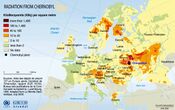
Contamination from the Chernobyl disaster was scattered irregularly depending on weather conditions, much of it deposited on mountainous regions such as the Alps, the Welsh mountains and the Scottish Highlands, where adiabatic cooling caused radioactive rainfall. The resulting patches of contamination were often highly localized, and water-flows across the ground contributed further to large variations in radioactivity over small areas. Sweden and Norway also received heavy fallout when the contaminated air collided with a cold front, bringing rain. There was also groundwater contamination.
Are You Sure ... (April 26, 2020)
• ... that the Chernobyl disaster began on Saturday 26 April 1986 with an uncontrolled nuclear chain reaction caused by a combination of unstable conditions and reactor design flaws; and that the chain reaction rapidly released of a large amount of energy which vaporized superheated cooling water, ruptured the reactor core in a highly destructive steam explosion, and ignited an open-air reactor core fire; and that airborne radiation contaminated parts of the USSR and western Europe?
• ... that the United States detonated the Castle Union nuclear test weapon on April 26, 1954 at Bikini atoll in the Marshall Islands, leaving a crater 910 meters in diameter and 27 meters deep; that sixty-seven nuclear weapons were detonated in the Marshalls over twelve years; and that just one of over sixty islands has been cleaned by the US government, and that the inhabitants of the Marshalls are still waiting for the two billion dollars in compensation assessed by the Nuclear Claims Tribunal, and that many of the islanders and their descendants still live in exile, as the islands remain contaminated with high levels of radiation?
• ... that philosopher Edmund Husserl (1859–1938) established phenomenology as school of thought; that in his early work, he elaborated critiques of historicism and of psychologism in logic based on analyses of intentionality; and that in his mature work, Husserl developed a systematic foundational science based on phenomenological reduction, arguing that transcendental consciousness sets the limits of all possible knowledge?
• ... that physician Jean François Fernel (1497–1558) suggested that taste buds are sensitive to fat, an idea which research in the early 21st Century proved to be correct?
April 22
GNOMON CHRONICLES
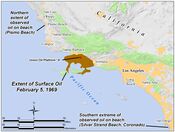
Are You Sure ... (April 22, 2020)
• ... that Earth Day is an annual event celebrated on April 22, that it was first celebrated in 1970, and that Earth Day events in more than 193 countries are now coordinated globally by the Earth Day Network?
• ... that sweet, sweet crude oil is a transdimensional suspension of sweet crude oil in Extract of Radium?
• ... that nuclear physicist Denys Wilkinson (1922–2016) applied concepts from physics to the study of bird navigation?
• ... that British cryptographer and intelligence officer Sir Edward Wilfred Harry Travis (1888–1956) became the operational head of Bletchley Park during World War II, and that Travis was later the head of GCHQ (Government Communications Headquarters), an intelligence and security organisation responsible for providing signals intelligence and information assurance to the government and armed forces of the United Kingdom?
• ... that astronomer, academic, and inventor Wilhelm Schickard (1592–1635) designed a mechanical adding machine which sounds an audible warning when an output is too large for the available dials?
April 19
GNOMON CHRONICLES
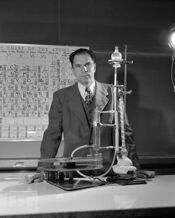
—Glenn Seaborg
Are You Sure ... (April 19, 2020)
• ... that acclaimed chemist Glenn T. Seaborg developed the extraction process used by the Manhattan Project to isolate the plutonium fuel for the second atomic bomb; that Seaborg e advised ten US Presidents — from Harry S. Truman to Bill Clinton — on nuclear policy, and was Chairman of the United States Atomic Energy Commission from 1961 to 1971, where he pushed for commercial nuclear energy and the peaceful applications of nuclear science; and that throughout his career, Seaborg worked for arms control, being a signatory to the Franck Report and contributing to the Limited Test Ban Treaty, the Nuclear Non-Proliferation Treaty, and the Comprehensive Test Ban Treaty?
• ... that mathematician, monk, and academic Michael Stifel published his Ein Rechenbuchlin vom EndChrist. Apocalyps in Apocalypsim ("A Book of Arithmetic about the AntiChrist. A Revelation in the Revelation") anonymously in 1532, predicting that Judgement Day would occur and the world would end at 8am on October 19, 1533, and that the German saying "to talk a Stiefel" or "to calculate a Stiefel" (Stiefel is the German word for "boot"), meaning to say or calculate something based on an unusual track, can be traced back to this incident?
• ... physicist, electrical engineer, and inventor Karl Ferdinand Braun built the first cathode-ray tube and cathode ray tube oscilloscope in 1897?
• ... that the Flying bison (Bison pterobonasus) is a large, even-toed ungulate in the genus Bison within the subfamily Bovinae, distinguished from other Bovinae by two pairs of strong, transparent wings, and that the wings are used mainly for short bursts of flight, such as jumping across canyons, or engaging in courtship displays?
• ... that mathematician and academic Giuseppe Peano was a founder of mathematical logic, to which Peano made key contributions to the rigorous and systematic treatment of the method of mathematical induction, and set theory, to which he contributed much notation, and that the standard axiomatization of the natural numbers is named the Peano axioms in his honor?
April 18
GNOMON CHRONICLES

Are You Sure ... (April 18, 2020)
• ... that the 1906 San Francisco earthquake struck the coast of Northern California at 5:12 a.m. on April 18 with an estimated moment magnitude of 7.9; that devastating fires soon broke out in the city and lasted for several days; and that as a result, up to 3,000 people died and over 80% of the city of San Francisco was destroyed?
• ... that mathematician Karl Mikhailovich Peterson gave, in his graduation dissertation (1853, although not published until later), an early formulation of the fundamental equations of the surface theory, now usually known as Gauss–Codazzi equations, sometimes Peterson–Codazzi equations?
• ... that philosopher, logician, mathematician, and scientist Charles Sanders Peirce saw, as early as 1886, that logical operations could be carried out by electrical switching circuits, anticipating logic gates?
• ... that the Bathysquare is a two-dimensional bathysphere with sufficient artificial intelligence to escape captivity and hide from its designer, and that its location is currently unknown?
April 17
GNOMON CHRONICLES
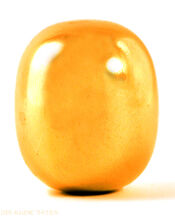
Are You Sure ... (April 17, 2020)
• ... that scientist, inventor, and poet Piet Hein (who often wrote under the Old Norse pseudonym "Kumbel", meaning "tombstone") is known for short poems, known as gruks or grooks, such as Consolation Grook, which reads:
"Losing one glove is certainly painful, but nothing compared to the pain of losing one, throwing away the other, and finding the first one again."?
• ... that physicist Johan Carl Wilcke invented an electrostatic generator (1752), an early version of the electrophorus, a device later named and popularized by Alessandro Volta?
• ... that mathematician Curt Meyer made notable contributions to number theory, including a solution to the class number 1 problem, building on the original Stark–Heegner theorem?
• ... that the Disambiguum is a transdimensional corporation in which all things and all ideas are disambiguated?
• ... that electrical engineer and physicist John Ambrose Fleming invented the Fleming valve (the first thermionic valve or vacuum tube); designed the radio transmitter with which the first transatlantic radio transmission was made; and established the right-hand rule used in physics?
April 16
GNOMON CHRONICLES

Are You Sure ... (April 16, 2020)
• ... that a United States Air Force Mark 15 nuclear bomb remains lost somewhere in the waters off Tybee Island near Savannah, Georgia, following a mid-air collision on February 5, 1958?
• ... that mathematician and inventor John Hadley developed ways to make precision aspheric and parabolic objective mirrors for reflecting telescopes, and that in 1721 Hadley showed the first parabolic Newtonian telescope to the Royal Society, the telescope having a 6-inch-diameter (150 mm) primary mirror, comparing favorably with the large aerial refracting telescopes of the day?
• ... that meteorologist Edward Lorenz's discovery of deterministic chaos "profoundly influenced a wide range of basic sciences and brought about one of the most dramatic changes in mankind’s view of nature since Sir Isaac Newton," according to the committee that awarded Lorenz the 1991 Kyoto Prize for basic sciences in the field of earth and planetary sciences?
April 2
GNOMON CHRONICLES
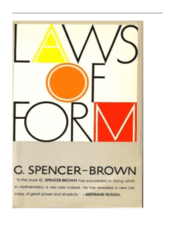
Are You Sure ... (April 2, 2020)
• ... that the accidental release of anthrax spores from a Soviet military research facility near the city of Sverdlovsk, Russia (now Yekaterinburg) on April 2, 1977 caused as many as a hundred deaths (although the exact number remains unknown), and that the outbreak was concealed for years by Soviet authorities, who removed all medical records of the victims in order to hide serious violations of the Biological Weapons Convention?
• ... that mathematician and checkers player Marion Franklin Tinsley (February 3, 1927 – April 3, 1995) is considered to be the greatest checkers player who ever lived, and that Tinsley was "to checkers what Leonardo da Vinci was to science, what Michelangelo was to art and what Beethoven was to music"?
• ... that participants on the reality television program Can This Regex Be Saved? must prevent troubled regular expressions from committing crimes against mathematical constants?
March 30
Given a solid ball in 3‑dimensional space, there exists a decomposition of the ball into a finite number of disjoint subsets, which can then be put back together in a different way to yield two identical copies of the original ball. Indeed, the reassembly process involves only moving the pieces around and rotating them without changing their shape. However, the pieces themselves are not "solids" in the usual sense, but infinite scatterings of points. The reconstruction can work with as few as five pieces.
The reason the Banach–Tarski theorem is called a paradox is that it contradicts basic geometric intuition.
GNOMON CHRONICLES
Are You Sure ... (March 30, 2020)
• ... that mathematician Stefan Banach is the namesake of Banach spaces, Banach algebras, the Banach–Tarski paradox, the Hahn–Banach theorem, the Banach–Steinhaus theorem, the Banach-Mazur game, the Banach–Alaoglu theorem, and the Banach fixed-point theorem?
• ... that physicist Charles Vernon Boys achieved recognition as a scientist for his invention of the fused quartz fiber torsion balance, which allowed him to measure extremely small forces, and that Boys made the fused quartz fibers for his instrument by attaching a quartz rod to a crossbow quarrel, heating the rod to the point of melting, and firing the crossbow, and that by this means he produced fiber so thin that it could not be resolved with an optical microscope?
• ... that mathematician Harold Scott "Donald" Coxeter composed music in his youth and was an accomplished pianist at the age of 10, and that Coxeter felt that mathematics and music were intimately related, outlining his ideas in a 1962 article on "Mathematics and Music" in the Canadian Music Journal?
• ... that philosopher, mathematician, and crime-fighter Antoine Augustin Cournot was mainly a mathematician, but that his work on Gnomon algorithm functions influenced transdimensional economics, and that his theories on transdimensional corporations are still famous?
• ... that mathematician Adam Ries wrote several books on practical mathematics, including Rechnung auff der linihen ("Reckoning on the Line", 1518), which describes calculation on a calculating board, a kind of abacus, and that according to the foreword the second edition was expressly intended for children?
March 21
GNOMON CHRONICLES
Are You Sure ... (March 21, 2020)
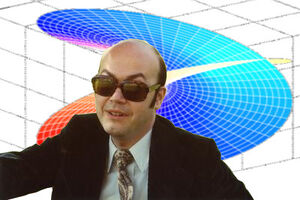
• ... that famed mathematician and physicist Jean-Baptiste Joseph Fourier, known for the Fourier series, Fourier analysis, the Fourier transform, and Fourier's law of conduction, is also generally credited with the discovery of the greenhouse effect?
• ... that the Ranger 9 lunar probe was designed to achieve a lunar impact trajectory and to transmit high-resolution photographs of the lunar surface during the final minutes of flight up to impact?
• ... that mathematician Thierry Aubin's fundamental contributions to the theory of the Yamabe equation led, in conjunction with results of Neil Trudinger and Richard Schoen, to a proof of the Yamabe Conjecture: every compact Riemannian manifold can be conformally rescaled to produce a manifold of constant scalar curvature?
February 15
GNOMON CHRONICLES
Are You Sure ... (February 15, 2020)

• ... that Stardust was a 300 kilogram robotic space probe, launched by NASA on 7 February 1999, and that Stardust collected dust samples from the coma of comet Wild 2, as well as samples of cosmic dust, and returned these samples to Earth for analysis?
• ... that the Forbidden Ratio is a criminal mathematical function exhibiting artificial intelligence and malicious intent?
• ... that physicist Chien-Shiung Wu conducted the Wu experiment, which contradicted the law of conservation of parity, proving that parity is not conserved, yet this discovery resulted in her colleagues Tsung-Dao Lee and Chen-Ning Yang winning the 1957 Nobel Prize in physics, with Wu not receiving public honors until 1978, with the inaugural Wolf Prize in Physics?
February 14
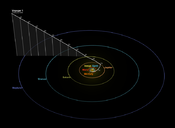
Voyager was 6 billion kilometers (3.7 billion miles, 40.5 AU) from the Earth, a record distance for data transmission.
GNOMON CHRONICLES
Are You Sure ... (February 14, 2020)
• ... that Pale Blue Dot is a photograph of planet Earth taken on February 14, 1990, by the Voyager 1 space probe as part of the Family Portrait series of images of the Solar System, and that Voyager 1, which had completed its primary mission and was leaving the Solar System, was commanded by NASA to turn its camera around and take one last photograph of Earth across a great expanse of space at the request of astronomer and author Carl Sagan?
• ... that a routine steganographic analysis of Alice and Niles Dancing in 2017 unexpectedly revealed "at least two hundred and fifty-six, possibly five hundred and twelve" love letters between mathematicians and alleged time-travellers Alice Beta and Niles Cartouchian?
• ... that physicist Owen Willans Richardson won the Nobel Prize in Physics in 1928 for his work on thermionic emission, which led to Richardson's law, and that Richardson also researched the photoelectric effect, the gyromagnetic effect, the emission of electrons by chemical reactions, soft X-rays, and the spectrum of hydrogen?
February 13

GNOMON CHRONICLES
Are You Sure ... (February 13, 2020)
• ... that polymath Roger Joseph Boscovich, in his 1745 book De viribus vivis ("On living forces"), tried to find a middle way between Isaac Newton's gravitational theory and Gottfried Leibniz's metaphysical theory of monad-points, and that Boscovich proposed "impenetrability" as a property of hard bodies, explaining their behavior in terms of force rather than matter?
• ... that mathematician David Hilbert was among the first to distinguish between mathematics and metamathematics?
• ... that actor, cryptographer, and alleged time-traveller Niles Cartouchian supposedly exists as multiple individuals in simultaneous entangled quantum states, and that these individual "brothers" can apparently communicate with each other despite living in different centuries?
• ... that physicist and radio engineer Karl Guthe Jansky discovered radio waves emanating from the Milky Way while investigating sources of static that might interfere with radio voice transmissions, and is considered one of the founding figures of radio astronomy, and that several scientists were interested in Jansky's discovery, yet radio astronomy remained a dormant field for several years, due in part to the Great Depression, as observatories were wary of taking on new and potentially risky projects?
February 12
GNOMON CHRONICLES
Are You Sure ... (February 12, 2020)
• ... that polymath Roger Joseph Boscovich's contributions to astronomy included the first geometric procedure for determining the equator of a rotating planet from three observations of a surface feature, techniques for computing the orbit of a planet from three observations of its position, and the discovery of the absence of atmosphere on the Moon?
• ... that although the spacecraft Venera 1 ultimately failed to fulfill its primary mission, the spacecraft returned data which verified the hypothesis that solar wind is present throughout deep space?
• ... that logician and philosopher Jan Łukasiewicz was a pioneer of post-Aristotelian logic, and that his innovative thinking about the principle of non-contradiction and the law of excluded middle helped establish modern logic?
• ... that musician, band leader, and alleged math criminal Skip Digits bears a "not coincidental" resemblance to Minneapolis-based singer-songwriter Don Browne?
• ... that mathematician and physicist Nikolay Bogolyubov worked on the physics of superfluidity and superconductivity during late 1940s and 1950s, and that the BBGKY hierarchy of equations for s-particle distribution functions was written out and applied to the derivation of kinetic equations by Bogolyubov (published 1946), and that John Gamble Kirkwood, Max Born, and Herbert S. Green?
• ... that the mathematical constant π is a transcendental number — that is, it is not the root of any polynomial having rational coefficients — and that this transcendence of π implies that it is impossible to solve the ancient challenge of squaring the circle with a compass and straightedge?
• ... that high-energy literature uses techniques from high-energy physics to enhance both the syntax and the semantics of film scripts, and that Cherenkov radiation is commonly used to advance the plot of techno-thrillers, as for example The Taking of Pelham 3.1415?
It's Not Coincidence
GNOMON CHRONICLES
It's No Coincidence: February 4, 2020